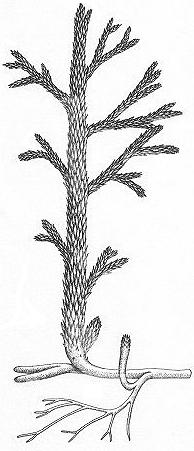- Asteroxylon
Taxobox
fossil_range = EarlyDevonian

image_width=150px
regnum =Plant ae
divisio =Lycopodiophyta
classis =Lycopodiopsida
ordo =Drepanophycales
familia =Asteroxylaceae
genus = "Asteroxylon"
genus_authority = Kidston & Lang 1920
species = "Asteroxylon mackiei"
species_authority = Kidston & Lang (Type species)"Asteroxylon" ("star-shaped xylem") is an
extinct genus of plants of the DivisionLycopodiophyta known from anatomically preserved specimens in an EarlyDevonian deposit of chert at Rhynie in North-East ScotlandKidston R & Lang WH (1920) On Old red sandstone plants showing structure from the Rhynie chert bed, Aberdeenshire. Part III. Asteroxylon mackiei, Kidston & Lang. Transactions of the Royal Society of Edinburgh 52, 643-680] that has been dated at 396 +/- 8million years oldRice, C. M., Ashcroft, W. A., Batten, D. J., Boyce, A. J., Caulfield, J. B. D., Fallick, A. E., Hole, M. J., Jones, E., Pearson, M. J., Rogers, G., Saxton, J. M., Stuart, F. M., Trewin, N. H. & Turner, G. 1995. A Devonian auriferous hot spring system, Rhynie, Scotland. Journal of the Geological Society, London, 152: 229-250] . "Asteroxylon" is probably astem group to theDrepanophycaceae .Fact|date=October 2007Description
"Asteroxylon" is a terrestrial genus of
vascular plant which flourished in the EarlyDevonian period. Dichotomously branching stems, which reached 12 mm in diameter and 40 cm in length, were erect, rising from a ground-running organ, from which also protruded underground "rhizoids" or "roots": these reached a depth of up to 20cm below the surface.cite journal
author = Smoot, E.L.
coauthors = Jansen, R.K.; Taylor, T.N.
year = 1981
title = A Phylogenetic Analysis of the Land Plants: A Botanical Commentary
journal = Taxon
volume = 30
issue = 1
pages = 65–67
url = http://links.jstor.org/sici?sici=0040-0262(198102)30%3A1%3C65%3AAPAOTL%3E2.0.CO%3B2-3
accessdate = 2007-10-11
doi = 10.2307/1219392] An actinostelic vascular bundle occupied the centre of the axes, withtracheid s being of primitive annular or helical type (so-called G-type). "Leaves" - not true leaves, but protrusions - were of the form of unbranched strap-shaped enations up to 5 mm long; a single vascular trace branched from the main bundle in the centre of the stem to terminate at the base of each enation. Enations and axes borestomata ."Asteroxylon" differs from externally similar genera of the same period,
Drepanophycus andBaragwanathia , as the vascular thread proceeding well into the leaf in these genera; seeDrepanophycales for more details.References
* [http://www.abdn.ac.uk/rhynie/intro.htm The Rhynie Chert and Asteroxylon]
Wikimedia Foundation. 2010.
